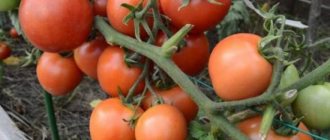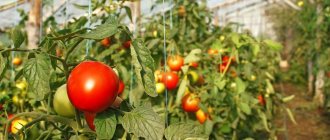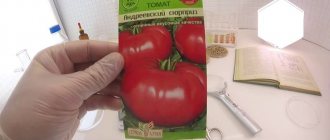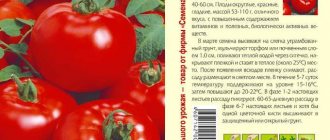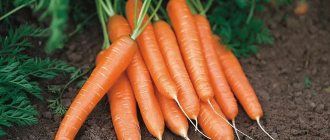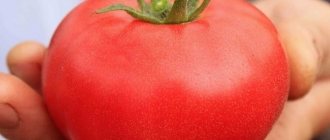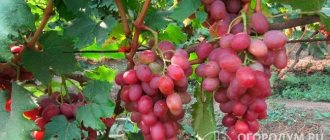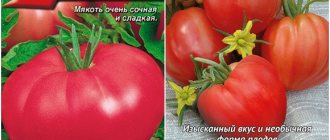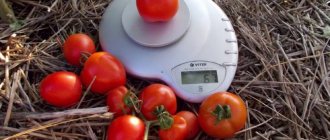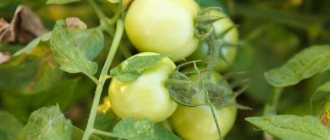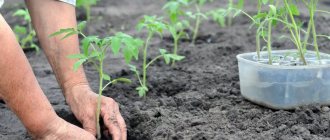Description of the tomato variety
The crop was bred for cultivation in the unprotected territory of the Rostov region, North Caucasus district, Stavropol and Krasnodar territories. In the central part of Russia, cultivation in a greenhouse is possible. Tomato “Anyuta” f1 (pictured), according to the copyright holder’s description, belongs to the ultra-early varieties. In warm climates, two harvests can be harvested per season. Ripening time: within 3 months from the moment of sowing the seeds. The first collection occurs in June. Replanted tomatoes ripen in late August - early September.
The tomato variety “Anyuta” f1 is a determinate species; the crop does not grow higher than 65 cm. The bush is standard, producing a minimum number of side shoots. Characteristics of tomatoes “Anyuta” f1:
- The plant does not require additional bush formation; the tomato is formed by one central trunk. The main stem is thick, woody, and light green in color. Easily withstands the weight of the fruit. The plant does not require fixation.
- The culture produces few shoots; they are used to form a crown; the color of the shoots is light green.
- The variety is intensely leafy, the leaves are medium-sized, oblong with carved edges and a slightly corrugated surface. Slightly pubescent.
- The tomato blooms with yellow self-pollinating flowers that produce 100% fruit.
- The bush forms 5 brushes every three leaves. The average density of each is 6 tomatoes. The filling capacity does not change; the weight of the fruits of the last circle will be lower than the first.
- The root system of the tomato “Anyuta” f1 fully nourishes the plant and ensures stability.
Description of fruits
According to reviews from vegetable growers, “Anyuta” f1 tomatoes ripen unevenly and have different weights. Description of the fruit of the variety:
- diameter about 7 cm, weight from 60 to 120 g, round shape, slightly pressed on top;
- the peel is thin, bright red, a dark yellow pigment is visible near the stalk at the ripening stage;
- the surface of the tomato is glossy, without ribbing, does not crack;
- The variety produces few seeds, they are located in 5 sections, planting material is not suitable for breeding the next generation of the crop;
- The pulp has a dense consistency, juicy, no voids, and at the stage of technical ripeness there are white fragments.
Advice!
The ultra-early variety is rarely used for winter harvesting, but the second harvest tomato “Anyuta” f1 is suitable for canning. Tomatoes have a sweet taste, the ratio of glucose to acid is 3:1.
Features of harvesting and storage
It is best to pick tomato fruits in the morning, when they are at their most elastic. In this case, mechanical damage should be avoided. The degree of ripeness of the tomatoes being harvested depends on their purpose. For quick use as salads, fully ripened fruits are collected. For longer storage, brown tomatoes are picked for subsequent ripening. This, among other things, promotes faster growth and ripening of the remaining fruits on the bushes.
The picked tomatoes, along with the stalk, are placed in a wooden or cardboard container in 3 rows, where they ripen for 3–5 days. The presence or absence of light does not matter in this case, but the temperature in the room should not be lower than +20°C.
The presence of red tomatoes contributes to the faster ripening of the rest, so if a longer shelf life of tomatoes is expected, ripened red fruits must be immediately removed from the storage location.
Tomatoes of the Anyuta variety can be stored fresh for up to 1 month. It should be borne in mind that during storage the fruits use sugar for the air exchange process, which is already insufficient in this variety, as in other very early ripening tomatoes.
In just over 10 years, tomatoes of the Anyuta variety have found their way onto many vegetable farms and homesteads. Their ultra-early ripening, ability to produce 2 harvests per season, disease resistance and high taste standards fully meet the requirements of modern vegetable growers.
Characteristics of the variety
The tomato variety was bred for cultivation in warm climates, and therefore is not frost-resistant. Well resists a number of diseases caused by bacteria or fungi. Tomatoes are grown in open ground on personal plots and farm fields.
Productivity and fruiting
Determinate varieties bear less fruit than tall crops. A feature of the tomato variety “Anyuta” f1, according to reviews from farmers, is the possibility of harvesting a double harvest. The ultra-wound crop ripens in 95 days; in June, after harvesting, new seedlings are planted on the plot. At the beginning of September, the next fruit harvesting takes place.
For 1 sq. m place 5 plants. One bush produces an average of 2.5 kg. The number of tomatoes per 1 m2 is 12 kg. During the season, double cultivation produces 24 kg. Therefore, the variety is popular for commercial cultivation. Negative factors that can affect the level of fruiting are lack of lighting. Tomato slows down the growing season in a shaded place.
Characteristics
The shape of the fruit is flat-round, quite dense, not prone to cracking. Average weight 95-120 grams . The color of the tomato is well defined red. According to recommendations, the Anyuta tomato variety is intended for salad purposes; reviews from gardeners speak of excellent taste in pickles, sauces, and juice.
You can compare the weight of fruits with other varieties in the table below:
| Variety name | Fetal weight |
| Anyuta | 95-120 grams |
| Doll | 250-400 grams |
| Summer resident | 55-110 grams |
| Lazy | 300-400 grams |
| The president | 250-300 grams |
| Brawler | 100-180 grams |
| Kostroma | 85-145 grams |
| Sweet bunch | 15-20 grams |
| Black bunch | 50-70 grams |
| Stolypin | 90-120 grams |
The average yield is 2.3 -2.7 kilograms per bush, when planting 6-7 plants 12.0-13.5 kg per square meter.
You can compare the yield of this variety with others in the table below:
| Variety name | Productivity |
| Anyuta | 12-13.5 kg per square meter |
| Nastenka | 10-12 kg per square meter |
| Bella Rosa | 5-7 kg per sq.m |
| Banana red | 3 kg per bush |
| Gulliver | 7 kg per bush |
| Lady Shady | 7.5 kg per square meter |
| Pink Lady | 25 kg per square meter |
| Honey Heart | 8.5 kg per bush |
| Fat Jack | 5-6 kg per bush |
| Broody | 10-11 kg per square meter |
Tomatoes of the Anyuta variety have a good presentation, excellent safety during transportation, and can be stored for up to a month at home.
On our website you will find a lot of useful information on how to properly grow tomato seedlings. Read all about planting seedlings at home, how long after planting the seeds sprout and how to water them correctly. And also how to grow tomatoes in twists, upside down, without soil, in bottles and using Chinese technology.
Area of application of fruits
The fruits of the “Anyuta” f1 tomato are stored for a long time without losing their gastronomic qualities. They are well transported to the place of sale. They supply tomatoes to retail outlets, restaurants and catering facilities. Eat fresh and make salads. In homemade preparations they are used for making juice, pickling, and canning.
Resistance to diseases and pests
Hybrid tomato "Anyuta f1" has good immunity against common nightshade infections. The variety is not affected by: macrosporiosis, a type of fruit and root rot, mosaic, fruit cracking. Possible late blight. Among the insects that parasitize the crop are nematodes, larvae of the Colorado potato beetle and whitefly moth, and less commonly, spider mites.
Advantages and disadvantages of the variety
Hybrid tomato species rarely have serious deficiencies. During experimental cultivation, breeders eliminate the shortcomings of the variety. The conditional disadvantages of the “Anyuta” f1 tomato include average resistance to pests and the need for sufficient lighting. Excess or deficiency of moisture is not relevant for tomatoes.
According to vegetable growers, Anyuta f1 tomatoes (pictured) are characterized by a number of advantages:
- grown in open ground and protected structures;
- good taste and aesthetic presentation;
- the variety reaches biological ripeness at the beginning of summer;
- Two crops are harvested per season;
- tomato is undemanding to watering;
- resists diseases well;
- The fruits are of a convenient size, suitable for preservation.
A universal tomato.
Advantages and disadvantages of the variety
Tomato Anyuta is an early ripening hybrid, unpretentious to the composition of the soil. Its fruits have thick skin that protects them from damage during transportation.
One of the advantages of the variety is its short ripening period, which allows harvesting twice per season.
pros
- resistance to diseases and pests;
- excellent taste;
- ultra-short ripening period;
- small size of bushes.
Minuses
- low sugar content due to early ripening;
- not suitable for cultivation in some regions of the Russian Federation.
You can grow the Anyuta tomato both in greenhouse conditions and in an open garden bed without additional shelter.
Growing rules
The tomato variety “Anyuta” f1 is bred with purchased seeds. The crop is planted in a place of permanent vegetation in the form of seedlings.
Planting seedlings
The time for sowing seeds for seedlings is the beginning of March; if secondary planting is planned, the seedlings are harvested in May. Preparatory work:
- Make a soil mixture of peat and humus at a ratio of 2:1.
- The seeds are soaked for 6 hours in a growth stimulator, dried and placed in the refrigerator for a day.
- Soil is poured into sowing containers (boxes, containers, peat cups).
- Deepen the planting material by 2 cm (2 seeds per 3 cm).
- Moisturize well and cover with soil.
- Cover the top with transparent material.
The containers are placed in a lighted room with a temperature of + 230 C. When shoots appear, the containers are opened and complex fertilizers are applied. After 3 leaves appear, the seedlings are planted. If the seeds are planted in glasses, picking is not required.
Transfer
The site for transplanting the “Anyuta” f1 tomato is chosen to be well-lit. Dig up the soil in advance and add organic matter mixed with wood ash. Seedlings are placed in open ground in mid-May, when 5 leaves have formed on the plant. Tomatoes can be planted in the greenhouse in early May. Determinate, standard shrub does not take up much space. The planting scheme in open ground does not differ from the method of planting in a greenhouse.
Aftercare
Agricultural technology for the “Anyuta” f1 tomato does not require special methods. For normal growing season of the variety it is recommended:
- Water twice a week; the top layer of soil should not be allowed to dry out; overmoistening is also undesirable.
- For better development of the root system and moisture conservation, mulch the holes with humus, peat, and sawdust.
- Loosen the soil as needed.
- Remove weeds from the garden bed.
- Feed tomatoes with phosphorus and potassium fertilizers during flowering and fruit ripening.
Tomato "Anyuta" f1 does not need fixation to the trellis and pruning of stepsons.
How to grow tomatoes
A plot of land for a permanent place for tomatoes is prepared in advance. In the fall, the soil is dug up and fertilized; in the spring, weeds are loosened and removed.
Sprouts are planted in open ground in mid-May in the evening or on a cloudy day. In the greenhouse the plant will take root in early May. The main condition: the air temperature at night should remain at +15. By the time the seedlings are transplanted, they already have a powerful stem, the height of which is not less than 25 cm.
Tomatoes are planted in beds in a checkerboard pattern with a distance of 35 cm between the bushes in the row. The row spacing is 65 cm. A few days before transplanting, nitrogen fertilizers are applied to the soil.
The first watering is carried out three days after planting.
Reference! Water strictly at the root, without splashing drops of water on the surface of the soil, to avoid shedding of flowers and damage by fungal diseases.
Until the first ovaries appear, it is enough to keep the soil moist. As soon as the fruits begin to gain weight and color, the volume of watering is increased. But there is no need to allow the soil to become waterlogged; this will affect the taste of the vegetables and can lead to cracking of the fruits.
After watering, the soil is loosened, the bushes are hilled up and weeds with roots are removed. To better retain moisture, they resort to mulching the beds with sawdust or peat. Mulching also promotes better development of the root system.
The first feeding is carried out after 3 weeks. Use nitrophoska and liquid fertilizer “Ideal”: 1 tablespoon of each per 10 liters of water. 0.5 liters of solution is poured under each caste.
The first flower clusters require a new portion of fertilizer. “Senor Tomato” works well here (1 tablespoon per 10 liters of water). For one bush, 1 liter is enough. After the next three weeks, apply a superphosphate solution (1 tablespoon per 10 liters of water).
Organic matter is good as a fertilizer, for example, bird droppings or weed infusion. The concentrate ratio is 1:15, to avoid burns to the plant roots.
Reference! The application of organic fertilizers increases the number of ripe fruits.
With weak development of bushes, foliar feeding, for example, a urea solution, helps. The vegetable crop is sprayed with it, having previously dissolved 1 tablespoon of fertilizer in 5 liters of water.
According to the stated characteristics and numerous reviews, the Anyuta F1 tomato does not require pinching, but gardeners have different opinions about the garter. Experienced gardeners do not recommend neglecting the garter.
Diseases and pests
The average resistance of tomato crops to late blight requires knowledge of methods for preventing and controlling this disease.
The affected parts of the plant are removed, followed by treatment with Bordeaux mixture, Barrier, and Fitosporin. These drugs destroy the fungal spores that cause the infection. Copper sulfate is used to prevent diseases.
Reference! When fruits ripen, it is recommended to use biological rather than chemical agents.
Plants are protected from harmful insects by covering the beds with wood ash or tobacco dust. Regular inspection of bushes for pests is also an effective prevention method.
Pest and disease control
It is not recommended to place the “Anyuta” f1 tomato near nightshade crops. The planting site must be changed every 3 years. If late blight develops on tomatoes, it is necessary to remove the affected parts from the plant, treat the variety with Bordeaux mixture, Barrier, and Fitosporin preparations. The products will destroy fungal spores, the cause of infection.
Attention! Treatment with chemicals during fruit ripening is not recommended; it is better to use biological agents (“Skor”).
To prevent diseases, tomatoes are treated with copper sulfate.
To destroy insects parasitizing on tomatoes, use:
- “Fitoverm” for whiteflies, irrigate the lower part of the leaf, the place where caterpillars accumulate;
- “Anti-mite”, “Carbophosphorus” for spider mites;
- “Iskra”, “Prestige” will destroy the Colorado potato beetle.
The remaining larvae are collected by hand.
Plant care rules
It is easier to care for the compact hybrid Anyuta in the garden than for tall tomatoes. Care involves:
- hydration;
- fertilizer;
- loosening the earth;
- weeding from weeds.
To make tomatoes bear fruit longer, the bushes are sprayed with a solution prepared from a liter of milk and 30 drops of iodine.
Watering
In the southern regions, where summers are dry and hot, tomatoes need irrigation. Once or twice a week, about 5 liters of water heated in the sun are poured under each bush, the soil is loosened, and the plants are hilled up.
Top dressing
10–14 days after planting tomatoes, they resort to fertilizer. To do this, take 1 kg of mullein, 20 g of superphosphate and a bucket of liquid. Tomatoes react positively to feeding with mineral complexes, ash and solutions of fermented grass.
The bushes are fertilized several times during the summer, always before flowering and ovary formation. Although the tomatoes are not tall, the stem is attached to a support, and when lateral layers appear, they are pruned. In the south, these shoots are planted in the ground, and a full-fledged bush grows from them.
See also
Description of the Shakira hybrid tomato and features of growing the plant
Read
Pest protection
Tomato leaves attract whiteflies, spider mites, aphids, and the Colorado potato beetle. In order to prevent an insect resembling a moth from destroying the tomatoes, the ground near the bushes is sprinkled with ash, tobacco dust, and the plants are sprayed with quicklime. When a pest appears, tomatoes are treated with Confidor or Fitoverm.
To combat spider mites, use “Karbofos” or prepare an infusion of dandelion and garlic. To cope with the Colorado potato beetle and aphids, insecticides “Iskra” and “Aktara” are used.
Diseases and their prevention
The hybrid tomato Anyuta does not suffer from root rot and mosaic, and is resistant to cladosporiosis. To prevent the appearance of other diseases, follow the rules of agricultural technology, spray the bushes with Bordeaux mixture or purchased fungicides.
Collection and storage
The first tomatoes are picked in June and put in salads and eaten fresh. Fruits that ripen in autumn are used for canning, making juice, sauces, pickling and salting. In a cool place they do not spoil for a whole month.
Similar varieties
Several more varieties deserve attention, which according to their characteristics are suitable for obtaining an early harvest.
Anna Rushen
The mid-early variety belongs to the semi-determinate species. On bushes up to one and a half meters high, fruits weighing about 300 g ripen. Pink-red tomatoes are distinguished by their heart-shaped shape. Juicy tomatoes have a sweetish taste, practically no seeds, and are used for making juices and fresh salads.
Annetta
The indeterminate variety is a mid-early variety. The bushes grow to a height of 1.8-3 m, so the plants must be constantly monitored. Round-shaped tomatoes ripen weighing 100-180 g, are easily transported and stored. Tomatoes are suitable for salads and canning. Annette's advantages are drought and cold resistance, but it will not be possible to harvest twice in a season.
